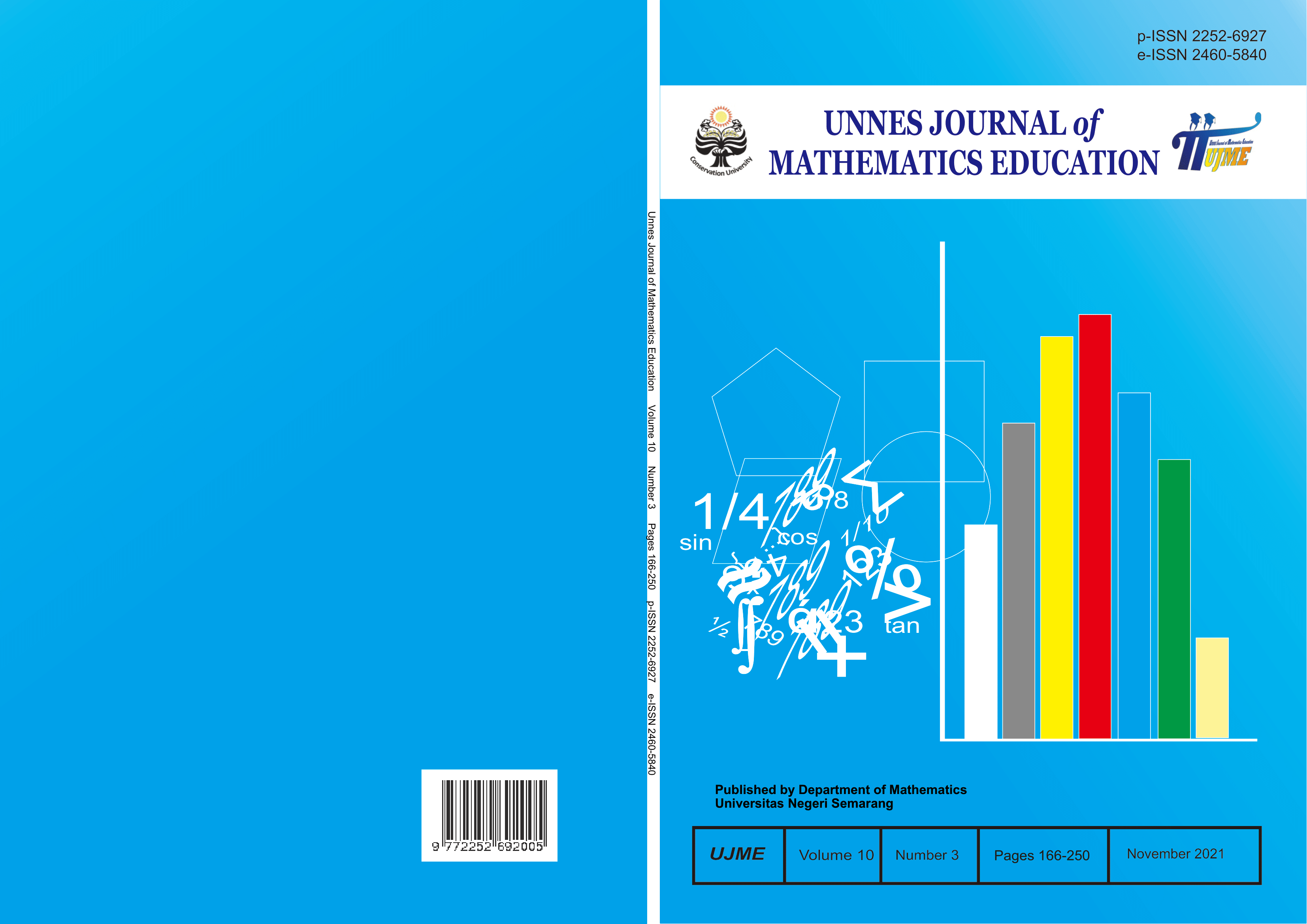The development of student worksheets based on guided discovery with STEM-nuances to improve mathematical reasoning ability of class VII students
##plugins.themes.academic_pro.article.main##
Abstract
The research aims to develop student worksheets based on guided discovery with STEM-nuances to improve mathematical reasoning ability. The type of this research is Research and Development (R&D) by modification models from Sugiyono. The research was carried out through the analysis of potentials and problems, data collection, product design, validation, revision, product trial, and final product. The result of validity test show that student worksheets based on guided discovery with STEM-nuances to improve mathematical reasoning ability are valid with average score 4,67 and practical with average score 3,79. The analysis of pretest and posttest data showed that student worksheets effective to improve mathematical ability with the n-gain score 0,63 on medium category. Therefore, the student worksheets based on guided discovery with STEM-nuances to improve mathematical reasoning ability are valid, practical, and effective.
##plugins.themes.academic_pro.article.details##
References
Annajmi, A., & Asra, A. (2017). Pengembangan Lembar Kegiatan Siswa (LKS) Berbasis Metode Penemuan Terbimbing untuk Meningkatkan Kemampuan Pemahaman Konsep Matematik Siswa Kelas VII SMP Islam Kepenuhan Kabupaten Rokan Hulu. Jurnal Eksakta Pendidikan (JEP), 1(1), 39-46.
Ario, M. (2016). Analisis Kemampuan Penalaran Matematis Siswa SMK Setelah Mengikuti Pembelajaran Berbasis Masalah. Jurnal Ilmiah Edu Research, 5(2), 125-134.
Depdiknas. (2008). Panduan Pengembangan Bahan Ajar. Jakarta: Departemen Pendidikan Nasional.
Jami’atun, S., & Wijayanti, K. (2020). Kemampuan Penalaran Matematis pada Pembelajaran TTW (Think Talk Write) Ditinjau dari Gaya Belajar Siswa. In PRISMA, Prosiding Seminar Nasional Matematika (Vol. 3, pp. 599-604).
Lestari, K. E., & Yudhanegara, M. R. (2015). Penelitian pendidikan matematika. Bandung: PT Refika Aditama, 2(3).
Mann, E. L. (2020). Mathematics. Journal for the Education of the Gifted (2). 80–85.
Nuridawani, N., Munzir, S., & Saiman, S. (2015). Peningkatan kemampuan penalaran matematis dan kemandirian belajar siswa Madrasah Tsanawiyah (MTs) melalui pendekatan Contextual Teaching and Learning (CTL). Jurnal Didaktik Matematika, 2(2).
Nurrahmah, A., & Suhendar, A. M. (2017). Peningkatan Hasil Belajar Matematika dengan Menggunakan Lembar Kerja Siswa (LKS) dan Kartu Keaktifan Siswa (KKS). JKPM (Jurnal Kajian Pendidikan Matematika), 3(1), 1-10.
OECD. (2016). PISA 2018 Assesment and Analytical Framework, Mathematics and Science. Paris: OECD Publishing.
Putra, A., & Syarifuddin, H. (2019). Analisis Kebutuhan Pengembangan Lembar Kerja Siswa Berbasis Penemuan Terbimbing Kelas VIII Sekolah Menengah Pertama. Jurnal Edukasi Matematika Dan Sains, 6(1), 39-49.
Putra, A., Syarifuddin, H., & Zulfah, Z. (2018). Validitas Lembar Kerja Peserta Didik Berbasis Penemuan Terbimbing dalam Upaya Meningkatkan Pemahaman Konsep dan Kemampuan Penalaran Matematis. Edumatika: Jurnal Riset Pendidikan Matematika, 1(2), 56-62.
Safitri, Y., & Arnawa, I. R. (2019). Mathematics Learning Device Development Based On Constructivism Approach To Improve Mathematical Reasoning Skill Of Class X Students In Vocational High School (SMK). International Journal of Scientific & Technology Research, 8(5), 131-135.
Sari, R. N. (2015). Peningkatan kemampuan penalaran matematis siswa SMP melalui pembelajaran penemuan terbimbing. PYTHAGORAS: Journal of the Mathematics Education Study Program, 4(2).
Sugiyono. (2016). Metode Penelitian Pendidikan Pendekatan Kuantitatif, Kualitatif, dan R & D. Bandung: Alfabeta.
Thahir, A., Anwar, C., Saregar, A., Choiriah, L., Susanti, F., & Pricilia, A. (2020). The Effectiveness of STEM Learning: Scientific Attitudes and Students’ Conceptual Understanding. In Journal of Physics: Conference Series (Vol. 1467, No. 1, p. 012008). IOP Publishing.
Wicaksono, D. P., Kusmayadi, T. A., & Usodo, B. (2014). Pengembangan perangkat pembelajaran matematika berbahasa inggris berdasarkan teori kecerdasan majemuk (multiple intelligences) pada materi balok dan kubus untuk kelas VIII SMP. Jurnal Elektronik Pembelajaran Matematika, 2(5), 534-549
